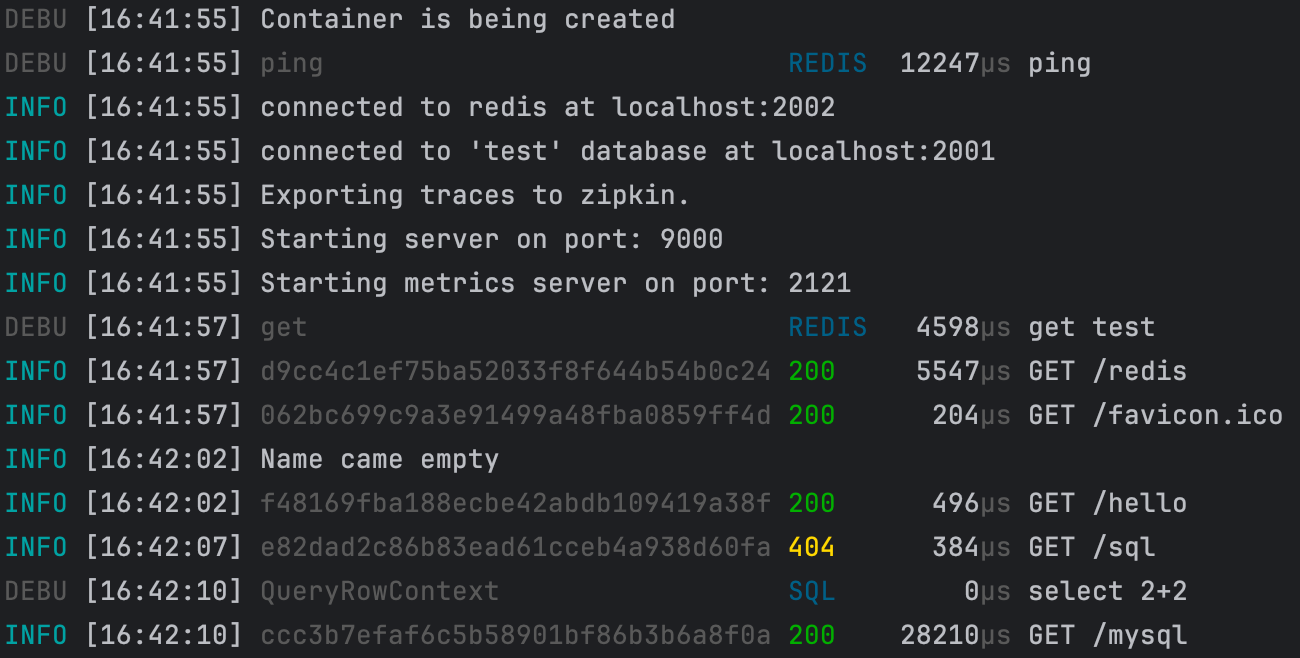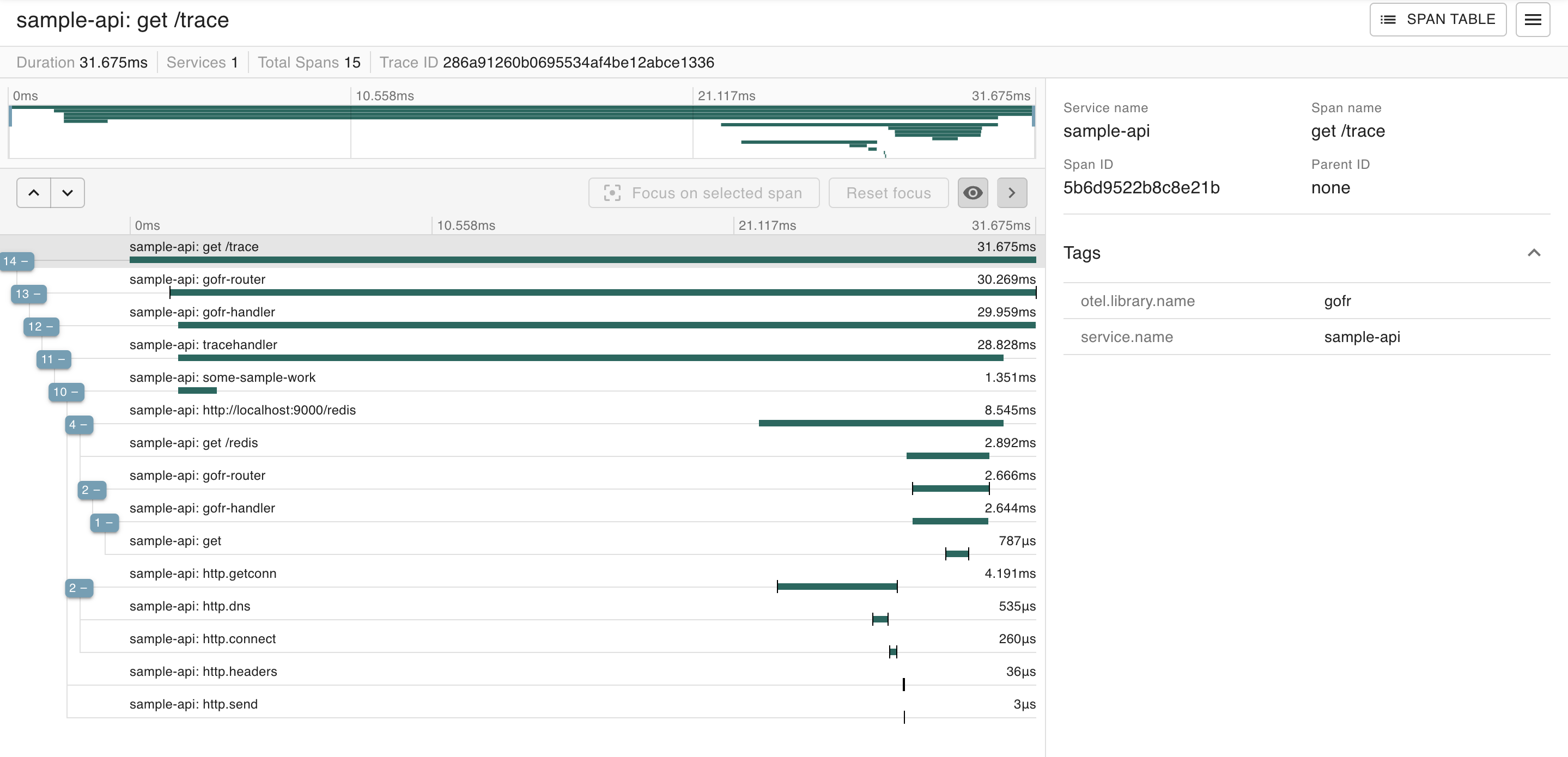Quick Start Guide
Observability
GoFr, by default, manages observability in different ways once the server starts:
Logs
Logs offer real-time information, providing valuable insights and immediate visibility into the ongoing state and activities of the system. It helps in identifying errors, debugging and troubleshooting, monitor performance, analyzing application usage, communications etc.
GoFr logger allows customizing the log level, which provides flexibility to adjust logs based on specific needs.
Logs are generated only for events equal to or above the specified log level; by default, GoFr logs at INFO level. Log Level can be changed by setting the environment variable LOG_LEVEL value to WARN,DEBUG,ERROR,NOTICE or FATAL.
When the GoFr server runs, it prints a log for reading configs, database connection, requests, database queries, missing configs, etc. They contain information such as request's correlation ID, status codes, request time, etc.

Logs are well-structured, they are of type JSON when exported to a file, such that they can be pushed to logging systems such as Loki, Elasticsearch, etc.
Metrics
Metrics enable performance monitoring by providing insights into response times, latency, throughput, resource utilization, tracking CPU, memory, and disk I/O consumption across services, facilitating capacity planning and scalability efforts.
Metrics play a pivotal role in fault detection and troubleshooting, offering visibility into system behavior.
They are instrumental in measuring and meeting service-level agreements (SLAs) to ensure expected performance and reliability.
GoFr publishes metrics to port: 2121 on /metrics endpoint in Prometheus format.
| Name | Type | Description |
|---|---|---|
| app_go_numGC | gauge | Number of completed Garbage Collector cycles |
| app_go_routines | gauge | Number of Go routines running |
| app_go_sys | gauge | Number of total bytes of memory |
| app_sys_memory_alloc | gauge | Number of bytes allocated for heap objects |
| app_sys_total_alloc | gauge | Number of cumulative bytes allocated for heap objects |
| app_info | gauge | Number of instances running with info of app and framework |
| app_http_response | histogram | Response time of HTTP requests in seconds |
| app_http_service_response | histogram | Response time of HTTP service requests in seconds |
| app_sql_open_connections | gauge | Number of open SQL connections |
| app_sql_inUse_connections | gauge | Number of inUse SQL connections |
| app_sql_stats | histogram | Response time of SQL queries in milliseconds |
| app_redis_stats | histogram | Response time of Redis commands in milliseconds |
| app_pubsub_publish_total_count | counter | Number of total publish operations |
| app_pubsub_publish_success_count | counter | Number of successful publish operations |
| app_pubsub_subscribe_total_count | counter | Number of total subscribe operations |
| app_pubsub_subscribe_success_count | counter | Number of successful subscribe operations |
For example: When running the application locally, we can access the /metrics endpoint on port 2121 from: http://localhost:2121/metrics
GoFr also supports creating custom metrics.
Example Dashboard
These metrics can be easily consumed by monitoring systems like Prometheus and visualized in dashboards using tools like Grafana.
Here's a sample Grafana dashboard utilizing GoFr's metrics:
Tracing
Tracing is a powerful tool for gaining insights into your application's behavior, identifying bottlenecks, and improving system performance. A trace is a tree of spans. It is a collective of observable signals showing the path of work through a system. A trace on its own is distinguishable by a TraceID.
In complex distributed systems, understanding how requests flow through the system is crucial for troubleshooting performance issues and identifying bottlenecks. Traditional logging approaches often fall short, providing limited visibility into the intricate interactions between components.
Automated Tracing in GoFr
GoFr automatically exports traces for all requests and responses. GoFr uses OpenTelemetry , a popular tracing framework, to automatically add traces to all requests and responses.
Automatic Correlation ID Propagation:
When a request enters your GoFr application, GoFr automatically generates a correlation-ID X-Correlation-ID and adds it to the response headers. This correlation ID is then propagated to all downstream requests. This means that user can track a request as it travels through your distributed system by simply looking at the correlation ID in the request headers.
Configuration & Usage:
GoFr has support for following trace-exporters:
1. Zipkin:
To see the traces install zipkin image using the following Docker command:
docker run --name gofr-zipkin -p 2005:9411 -d openzipkin/zipkin:latest
Add Tracer configs in .env file, your .env will be updated to
APP_NAME=test-service
HTTP_PORT=9000
REDIS_HOST=localhost
REDIS_PORT=6379
DB_HOST=localhost
DB_USER=root
DB_PASSWORD=root123
DB_NAME=test_db
DB_PORT=3306
# tracing configs
TRACE_EXPORTER=zipkin
TRACER_URL=http://localhost:2005/api/v2/spans
TRACER_RATIO=0.1
LOG_LEVEL=DEBUG
[!NOTE] If the value of
TRACER_PORTis not provided, GoFr uses port9411by default.
Open zipkin and search by TraceID (correlationID) to see the trace.

2. Jaeger:
To see the traces, install Jaeger image using the following Docker command:
docker run -d --name jaeger \
-e COLLECTOR_OTLP_ENABLED=true \
-p 16686:16686 \
-p 14317:4317 \
-p 14318:4318 \
jaegertracing/all-in-one:1.41
Add Jaeger Tracer configs in .env file, your .env will be updated to
# ... no change in other env variables
# tracing configs
TRACE_EXPORTER=jaeger
TRACER_URL=localhost:14317
TRACER_RATIO=0.1
Open jaeger and search by TraceID (correlationID) to see the trace.

3. OpenTelemetry Protocol:
The OpenTelemetry Protocol (OTLP) underlying gRPC is one of general-purpose telemetry data delivery protocol designed in the scope of the OpenTelemetry project.
Add OTLP configs in .env file, your .env will be updated to
# ... no change in other env variables
# tracing configs
TRACE_EXPORTER=otlp
TRACER_URL=localhost:4317
TRACER_RATIO=0.1
4. GoFr Tracer:
GoFr tracer is GoFr's own custom trace exporter as well as collector. Users can search a trace by its TraceID (correlationID) in GoFr's own tracer service, available anywhere, anytime.
Add GoFr Tracer configs in .env file, your .env will be updated to
# ... no change in other env variables
# tracing configs
TRACE_EXPORTER=gofr
TRACER_RATIO=0.1
[!NOTE]
TRACER_RATIOrefers to the proportion of traces that are exported through sampling. It ranges between 0 and 1. By default, this ratio is set to 1, meaning all traces are exported.Open gofr-tracer and search by TraceID (correlationID) to see the trace.
Custom Authentication Headers
Many observability platforms require custom headers for authentication. GoFr supports this through the TRACER_HEADERS configuration, which accepts comma-separated key=value pairs following the OpenTelemetry standard format.
Usage Examples
Single Header:
# Honeycomb
TRACER_HEADERS="X-Honeycomb-Team=your_api_key"
Multiple Headers:
# Grafana Cloud with multiple headers
TRACER_HEADERS="Authorization=Basic base64encodedcreds,X-Scope-OrgID=tenant-1"
# API key with special characters
TRACER_HEADERS="X-Api-Key=secret123,Authorization=Bearer token"
Configuration Example
Here's an example for sending traces to Grafana Cloud with authentication:
APP_NAME=my-service
# Grafana Cloud OTLP endpoint with authentication
TRACE_EXPORTER=otlp
TRACER_URL=otlp-gateway-prod-us-east-0.grafana.net:443
TRACER_HEADERS="Authorization=Basic dXNlcm5hbWU6cGFzc3dvcmQ=,X-Scope-OrgID=123456"
TRACER_RATIO=1.0